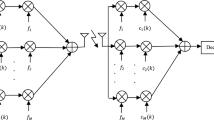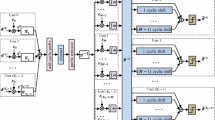Abstract
A hybrid Interference cancellation (HIC) technique employing both Parallel and Successive Interference Cancellation (PIC/SIC) is proposed for Overloaded Direct Sequence Code Division Multiple Access (OCDMA) system under imperfect synchronization. Two types of receivers are proposed to efficiently mitigate the multiuser interference (MUI). In type I receiver, the MUI within group-1 users are first cancelled using Parallel Interference Cancellation (PIC). Then the multistage Successive Interference Cancellation (m-SIC) is performed on the resultant output of PIC to efficiently cancel the interference of group-2 users on group-1 users. The type II receiver is designed by performing PIC immediately followed by SIC and this combined process is repeated till a major chunk of multi user interference is cancelled. The BER performance of type II receiver is proved to be better than other cancellation techniques such as PIC, SIC and the proposed type I receiver.







Similar content being viewed by others
Explore related subjects
Discover the latest articles, news and stories from top researchers in related subjects.References
Cho, Y., & Lee, J. H. (1998). Analysis of an adaptive SIC for near-far resistant DS-CDMA. IEEE Transactions on Communications, 46, 1429–1432.
Djonin, D.V., & Bhargava, V. K. (2002). Spectral efficiency of the decision feedback receiver for two sets of orthogonal sequences. IEEE Communications Letters, 6(11), 497–499.
De Lamare, R. C., Sampaio-Neto, R., & Hjorungnes, A. (2007). Joint iterative interference cancellation and parameter estimation for CDMA systems. IEEE Communications Letters, 11(12), 916–918.
De Lamare, R. C., & Sampaio-Neto, R. (2008). Minimum mean squared error iterative successive parallel arbitrated decision feedback detectors for DS-CDMA systems. IEEE Transactions on Communications, 56(5), 778–789.
Divsalar, D., Simon, M. K., & Raphaeli, D. (1998). Improved parallel interference cancellation for CDMA. IEEE Transactions on Communications, 46, 258–268.
Donelen, H., & O’Farrell, T. (1999). Methods for generating sets of orthogonal sequences. Electronics Letters, 35, 1537–1538.
Riera-Palou, F., Femenias, G., & Ramis, J. (2007). BER analysis of group-orthogonal multicarrier code-division multiplex systems. Telecommunication Systems Journal, 36, 97–105. doi:10.1007/s11235-007-9051-3.
Fiebig, U. C. G. (1994). Auto- and crosscorrelation properties for extended msequences and related sequences. In IEEE Third International Symposium on Spread Spectrum Techniques and Applications, vol. 2, pp. 406–410.
Grant, A. J., & Alexander, P. D. (1998). Random sequence multisets for synchronous code-division multiple-access channels. IEEE Transactions on Information Theory, 44, 2832–2836.
Hamouda, W. A., & McLane, P. J. (2004). A fast adaptive algorithm for MMSE receivers in DS-CDMA systems. IEEE Signal Processing Letters, 11(4) 4
Honig, M., Woodward, G., & Sun, Y. (2004). Adaptive iterative multiuser decision feedback detection. IEEE Transactions on Wireless Communications, 3(2), 477
Houtum, V. (2001). Quasi-synchronous code-division multiple access with high-order modulation. IEEE Transactions on Communications, 49(7), 1240–1249.
Navaie, K. (2010). On the interference management in wireless multi-user networks. Telecommunication Systems Journal, 46, 135–148. doi:10.1007/s11235-010-9283-5.
Nobandegani, K. S., & Azmi, P. (2009). A new low SNR, correlated fading-suited space-time block code based on zero-padding and unitary transforms. Telecommunication Systems Journal, 41, 243–253. doi:10.1007/s11235-009-9159-8.
Kocian, A., & Fleury, B. H. (2003). EM-based joint data detection and channel estimation of DS-CDMA signals. IEEE Transactions on Communications, 51(10), 1709–1720.
Kumar, P., & Chakrabarti, S. (2008). “OCDMA/OCDMA overloading scheme for cellular DS-CDMA using orthogonal gold codes and complex scrambling”. International Journal of Computer Networks and Communications, 3, 207–283.
Learned, R. E., Willisky, A. S., & Boroson, D. M. (1997). Low complexity joint detection for oversaturated multiple access communications. IEEE Transactions on Signal Processing, 45, 113–122.
Lupas, R., & Verdu, S. (1989). Linear multiuser detectors for synchronous code-division multiple-access channels. IEEE Transactions on Information Theory, 35, 123–136.
Madhow, U., & Honig, M. L. (1994). MMSE interference suppression for direct-sequence spread spectrum CDMA. IEEE Transactions on Communications, 42, 3178–3188.
Patel, P., & Holtzman, J. M. (1993). Analysis of a DS/CDMA simple successive interference cancellation scheme using correlations. In IEEE GLOBECOM’ 93 (pp. 76–80). Houston.
Patel, P., & Holtzman, J. M. (1994). Analysis of a simple successive interference cancellation scheme in a DS/CDMA system. IEEE Journal on Selected Areas in Communications, 12, 796–807.
Ross, J. A. F., & Taylor, D. P. (1992). Vector assignment scheme for M+N users in N-dimensional global additive channel. IEEE Communications Letters, 28, 1634.
Ross, J. A. F., & Taylor, D. P. (1995). Multiuser signaling in the symbol-synchronous AWGN channel. IEEE Transactions on Information Theory, 41, 1174.
Rupf, M., & Massey, J. L. (1994). Optimum sequence multisets for synchronous code-division multiple-access channels. IEEE Transactions on Information Theory, 40, 1261–1266.
Sari, H., Vanhaverbeke, F., & Moeneclaey, M. (1999). Increasing the capacity of CDMA using hybrid spreading sequences and iterative multistage detection. In Vehicuar Technology Conference, Vol. 2, 1160–1164.
Sari, H., Vanhaverbeke, F., & Moeneclaey, M. (2000). Multiple access using two sets of orthogonal signal waveforms. IEEE Communications Letters, 4, 4–6.
Sari, H., Vanhaverbeke, F., & Moeneclaey, M. (2000). Extending the capacity of multiple access channels. IEEE Communications Magazine, 38, 74–82.
Sasipriya, S., & Ravichandran, C. S. (2010). A novel technique to increase the capacity of CDMA system using scrambled spreading sequences. International Journal of Engineering, Science and Technology, 2(5), 233–243.
Sasipriya, S., & Ravichandran, C. S. (2010). Technique to mitigate the effect of MUI in uplink overloaded CDMA system. In IEEE international conference on computational intelligence and computing research, ICCIC, 1–4.
Sasipriya, S., & Ravichandran, C. S. (2011). MMSE receiver for overloaded CDMA system. European Journal of Scientific Research, 51(4), 542–548.
Vanhaverbeke, F., Moeneclaey, M., & Sari, H. (2000). In An excess signaling concept with Walsh-Hadamard spreading and joint detection. Globecom 2000, San Francisco (Vol. 2, pp. 906–909).
Vanhaverbeke, F., Moeneclaey, M., & Sari, H. (2000). DS/CDMA with two sets of orthogonal sequences and iterative detection. IEEE Communications Letters, 4, 289–291.
Vanhaverbeke, F., & Moeneclaey, M. (2003). Evaluation of the critical load of parallel interference cancellation based on the PDA approach. In IEEE proceedings on personal, indoor and mobile radio communications, PIMRC 2003 (Vol. 2, pp. 1551–1554).
Vanhaverbeke, F., & Moeneclaey, M. (2004). An improved OCDMA/OCDMA scheme based on displaced orthogonal user sets. IEEE Communications Letters, 8, 265–267.
Varanasi, M., & Aazhang, B. (1990). Multistage detection in asynchronous code-division multiple-access communications. IEEE Transactions on Communications, 38, 509–519.
Verdu, S. (1984). Optimum multiuser signal detection. Ph.D thesis, University of Illinois at Urbana-Champaign.
Verdu, S. (1998). Multiuser detection. New York: Cambridge University Press.
Verdu, S., & Shamai, S. (1999). Spectral efficiency of CDMA with random spreading. IEEE Transactions on Information Theory, 45, 622–640.
Viswanath, P., & Anantharam, V. (1999). Optimal sequences and sum capacity of synchronous CDMA systems. IEEE Transactions on Information Theory, 45, 1984–1991.
Woodward, G., Ratasuk, R., Honig, M. L., & Rapajic, P. (2002). Minimum mean-squared error multiuser decision-feedback detectors for DS-CDMA. IEEE Transactions on Communications, 50(12), 2104–2112.
Tang, Z., Wei, G., & Zhu, Y. (2009). Weighted sum rate maximization for OFDM-based cognitive radio systems. Telecommunication Systems Journal, 42, 77–84. doi:10.1007/s11235-009-9170-0.
Author information
Authors and Affiliations
Corresponding author
Rights and permissions
About this article
Cite this article
Sasipriya, S., Ravichandran, C.S. Performance analysis of overloaded CDMA system under imperfect synchronization using Parallel/Successive Interference Cancellation. Telecommun Syst 56, 509–518 (2014). https://doi.org/10.1007/s11235-013-9762-6
Published:
Issue Date:
DOI: https://doi.org/10.1007/s11235-013-9762-6




